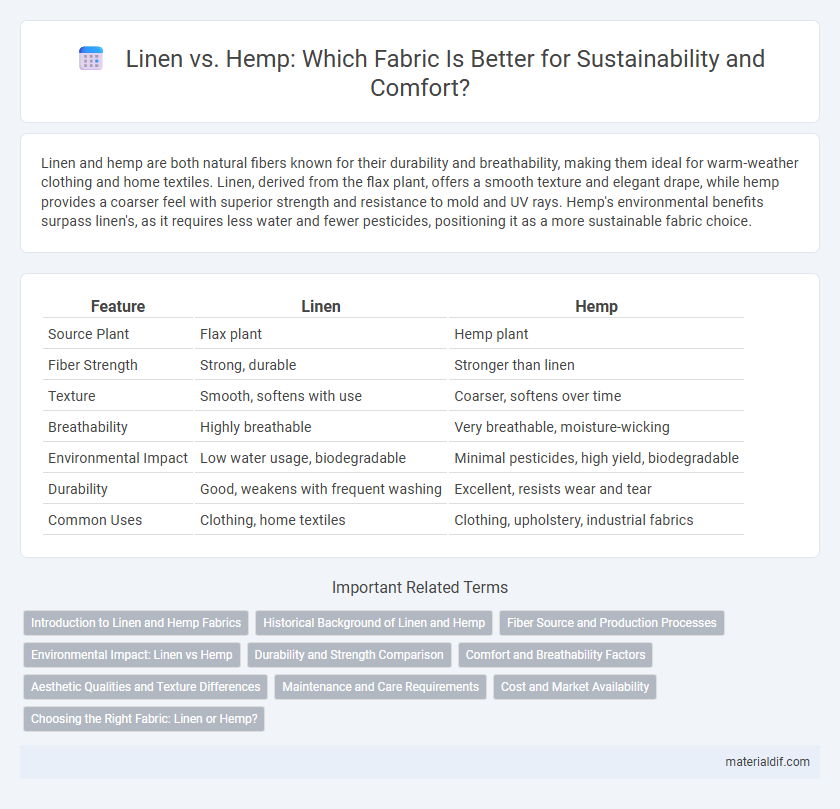Linen and hemp are both natural fibers known for their durability and breathability, making them ideal for warm-weather clothing and home textiles. Linen, derived from the flax plant, offers a smooth texture and elegant drape, while hemp provides a coarser feel with superior strength and resistance to mold and UV rays. Hemp's environmental benefits surpass linen's, as it requires less water and fewer pesticides, positioning it as a more sustainable fabric choice.
Table of Comparison
| Feature | Linen | Hemp |
|---|---|---|
| Source Plant | Flax plant | Hemp plant |
| Fiber Strength | Strong, durable | Stronger than linen |
| Texture | Smooth, softens with use | Coarser, softens over time |
| Breathability | Highly breathable | Very breathable, moisture-wicking |
| Environmental Impact | Low water usage, biodegradable | Minimal pesticides, high yield, biodegradable |
| Durability | Good, weakens with frequent washing | Excellent, resists wear and tear |
| Common Uses | Clothing, home textiles | Clothing, upholstery, industrial fabrics |
Introduction to Linen and Hemp Fabrics
Linen fabric, derived from the flax plant, is known for its durability, moisture-wicking properties, and natural luster, making it a popular choice for summer clothing and home textiles. Hemp fabric, made from the fibers of the hemp plant, offers exceptional strength, breathability, and environmental sustainability due to its rapid growth and minimal pesticide requirements. Both fabrics provide eco-friendly alternatives to cotton, with hemp often praised for its higher tensile strength and linen valued for its softness and smooth texture.
Historical Background of Linen and Hemp
Linen, derived from the flax plant, boasts a rich history dating back over 8,000 years, prominently used in ancient Egypt for its durability and breathability. Hemp, cultivated for more than 10,000 years, was a vital resource in early Chinese and Indus Valley civilizations, prized for its strong fibers and versatility in textiles and ropes. Both fabrics have played significant roles in human development, with linen symbolizing luxury and hemp illustrating sustainable utility throughout history.
Fiber Source and Production Processes
Linen is made from the fibers of the flax plant, which undergo retting, drying, and scutching to extract long, smooth fibers ideal for spinning. Hemp fabric derives from the stalks of the hemp plant, with its processing involving decortication, retting, and mechanical separation to produce coarse but durable fibers. Both fibers require retting, but hemp's robust stalks result in a stronger, more sustainable fabric compared to the finer flax fibers used in linen.
Environmental Impact: Linen vs Hemp
Hemp fabric requires significantly less water and pesticides compared to linen, making it a more sustainable choice for eco-conscious consumers. While both hemp and linen are derived from natural fibers, hemp's rapid growth cycle allows for higher yields per acre, reducing land use and soil depletion. The biodegradability of both materials contributes to their low environmental footprint, but hemp's superior carbon sequestration potential further enhances its eco-friendly credentials.
Durability and Strength Comparison
Linen and hemp fabrics are renowned for their exceptional durability and strength, with hemp fibers generally surpassing linen in tensile strength and resistance to wear. Hemp's dense fiber composition provides superior abrasion resistance and longevity, making it ideal for heavy-duty applications, while linen offers a softer texture but slightly less durability. Both materials benefit from natural breathability and increased strength over time, but hemp remains the stronger and more resilient fabric in comparative studies.
Comfort and Breathability Factors
Linen and hemp fabrics both excel in comfort and breathability, making them ideal for warm weather clothing. Linen, derived from flax fibers, offers exceptional softness and moisture-wicking properties that keep the skin cool and dry. Hemp fabric, known for its durability, provides superior ventilation and naturally resists odors, enhancing overall comfort during prolonged wear.
Aesthetic Qualities and Texture Differences
Linen showcases a smooth, slightly lustrous surface with a crisp hand, creating a refined and elegant aesthetic ideal for lightweight garments and home textiles. Hemp features a coarser, more textured feel with visible natural fibers, offering a rustic, earthy charm that enhances durability and breathability. Both fabrics present unique visual and tactile experiences, with linen leaning towards sophistication and hemp emphasizing rugged naturalism.
Maintenance and Care Requirements
Linen and hemp fabrics both require careful maintenance to preserve their durability and natural texture, but linen tends to be more delicate, needing gentle washing and lower heat drying to prevent damage. Hemp is more resilient, tolerating higher temperatures during washing and drying, which makes it easier to care for in everyday use. Both fabrics benefit from ironing while damp to maintain smoothness, but hemp's natural resistance to mold and UV damage reduces the need for intensive care compared to linen.
Cost and Market Availability
Linen generally costs more than hemp due to the labor-intensive process of harvesting and processing flax fibers, making it less accessible in budget-sensitive markets. Hemp offers a more cost-effective alternative with its faster growth cycle and higher yield per acre, resulting in broader market availability and competitive pricing. Both fabrics are eco-friendly, but hemp's affordability and widespread availability have driven increased adoption in sustainable textile industries.
Choosing the Right Fabric: Linen or Hemp?
Linen and hemp are both durable, breathable fabrics derived from natural fibers, making them excellent choices for sustainable textiles. Linen offers a softer texture with excellent moisture-wicking properties, ideal for lightweight clothing and home textiles, while hemp provides superior strength, antibacterial qualities, and resistance to UV light, suited for more rugged use like upholstery and outdoor wear. Selecting between linen and hemp depends on the desired fabric softness, durability, and environmental impact, with hemp typically being more eco-friendly due to its faster growth and lower water requirements.
Linen vs Hemp Infographic

 materialdif.com
materialdif.com